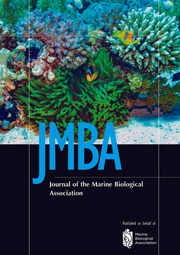Article contents
Growth, Metamorphosis and Energy Conversion in the Larvae of the Prawn, Palaemon Serratus
Published online by Cambridge University Press: 11 May 2009
Extract
The life-history of the larva of the prawn Palaemon serratus (Pennant) was studied in the laboratory and found to comprise a variable number of stages, dependent on feeding level and other factors. Larval moulting frequency was relatively constant at 3-day intervals, and could be followed in a population by daily examination for exuvia moult-casts. Length increase at each moult progressed arithmetically, and the highest mortalities occurred during metamorphosis. Consumption of Anemia nauplii by each larva rose from 30 to 400 per day. Populations of isolated animals (i.e. when cannibalism was excluded) were inspected daily and the exact number and duration of larval stages determined. Survival through metamorphosis was very high (over 85%) at both high and low feeding levels, although at the latter the larvae passed through more stages with more erratic duration times. At the end of the experiment, when all the larvae had metamorphosed, the mean dry weights at the high and low feeding levels were 7.7 and o.6 mg respectively. Larval stages could not be positively identified morphologically after stage III unless the history of the individual in question was known. It is suggested that the number of larval stages in the sea may also be very variable and difficult to determine.
Energy-conversion efficiency was calculated from food uptake measurements and larval growth estimations, and was found to be 50–60% during most of the larval life, falling to 35% when the early post-larvae were taken into account.
- Type
- Research Article
- Information
- Journal of the Marine Biological Association of the United Kingdom , Volume 49 , Issue 1 , February 1969 , pp. 77 - 96
- Copyright
- Copyright © Marine Biological Association of the United Kingdom 1969
References
- 47
- Cited by


